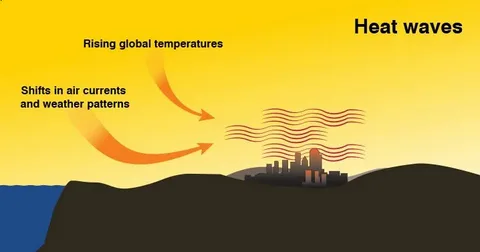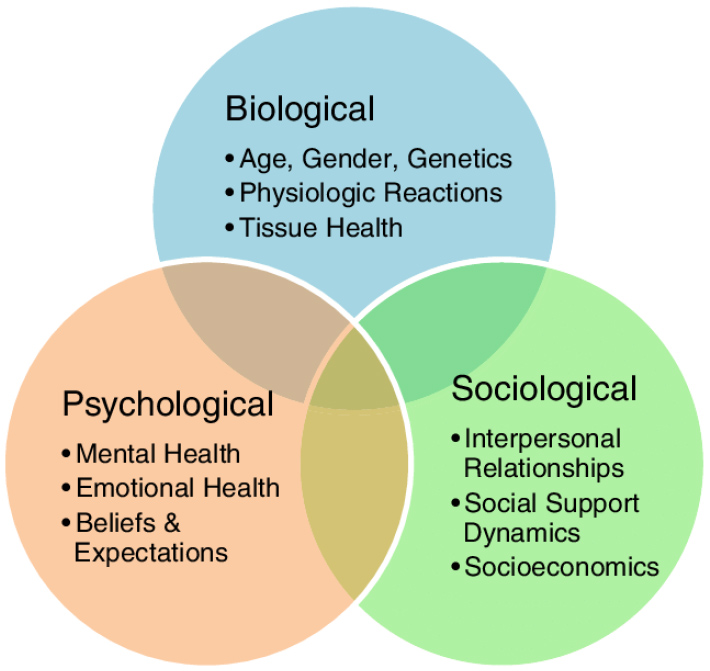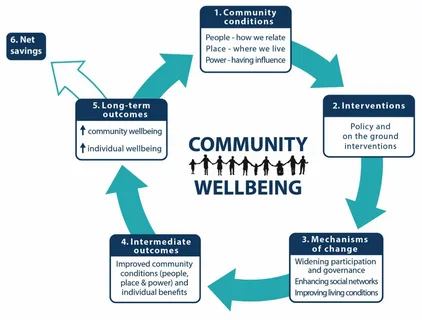Impact of Heat Waves on Mental Health:
Challenges and Strategies

1. Introduction
The consequences of heat stress on mental health imply a negative situation for segments of the population that may be more vulnerable to heat exposure or face prolonged and more frequent exposure to high temperatures, thus likely to remain neglected in parallel with the physical consequences of heat.
These are youths and old people, those with prolonged or chronic illnesses, and the ones with earlier diagnosed psychiatric diseases. Also, concrete jungle cities and communities might experience microclimates that cause the heat stress indices to be relatively higher as compared to suburban and rural settings.
Such social and environmental conditions have been assumed to result in a vulnerability synergy that cannot be effectively compensated by heat-risk communication alone, the re-organisation of thermoregulation control, and the enlargement of heat-alert warning systems to cope with heat wave periods that include both hot days and warm nights.
Excessive heat, or heat waves, which are described as several consecutive days or weeks of extremely hot conditions, are becoming more frequent, longer, and severe across the globe, and this has multiple impacts on the health of people and on society. The special common knowledge of heat waves and their acute relation to the physical health of individuals and communities now constitutes an existing base for policy measures to minimise these adverse effects.
However, certain aspects, such as the effects of heat stress on human health, particularly mental health, have not been given the same level of attention as the physical health impact of heat stress. Therefore, action to respond to strategies that safeguard mental health from high temperatures is yet to be formulated.
1.1. Definition and Causes of Heat Waves

Most importantly, the risk of heat stress affects everyone, though the following people are at higher risk due to the impairment of their thermoregulatory system; people with chronic diseases, the elderly due to poor ability to control their body temperatures, those who take many drugs, psychiatric and mental disorders, alcoholism, the poor, and the elderly, those living alone, or in houses where it’s difficult to cool down.
Even though the best known consequences are dehydration, overheating of the body, heat apoplexy, and heat collapse, heat waves also cause worsening of chronic conditions, reactions to short-term and chronic stress, sleep quality and duration shifts of the circadian rhythm, and increased physical violence.
It is commonly documented that high environmental temperatures affect neurobehavioral abnormalities, and disturbances in mood and cognitive functions have been noticed in workers and athletes, which include reduced attention, vigilance, reaction time, psychomotor function, and short-term memory.
In this regard, it is possible to open up the role of exposure to high environmental temperatures in the aggravation of the neurobehavioral pathology that is so characteristic of some forms of several psychiatric diseases. A cross-sectional survey of people with SMI reveals that several diseases have nothing to do with any diagnosis: fibromyalgia Nonalcoholic fatty liver disease, and migraine have 33% more risk factors exposed to heat.
Similarly, a large sample of international psychiatrists and mental health practitioners also confirmed that heat related suicide exists and is supported by other surveys. Other investigations reveal relations of the severest heat and several psychical illnesses, and the authors of these investigations state that worldwide mental health care continues to remain an underestimated issue. Possible impacts of heat waves on mental health are illustrated in the following Fig. 1.
Heat wave is a meteorological phenomenon normally referred to as a period of hot and sultry weather that may lead to social and health impacts on sensitive groups of people. Thus, in most countries, heat waves can be described as a sequence of the weather survey conducted for a range of subsequent days in which the temperatures are above a certain limit for a given region.
Investigations of the rising heat waves in the past century have revealed that the incidence of heat waves is increasing, the period for heat is increasing, heat waves are becoming hotter, and they are setting in earlier in their respective summer seasons in different parts of the world.
This is more so because of the resultant global warming and rising temperatures as a cause of climate change. Heat waves produce social, environmental, and macroeconomic impacts that are rather expensive to address in terms of health costs, assistance to agricultural crops, energy, and poor reimbursement for losses by employees. Heat waves are one of the most dangerous conditions because they take some time to build up; therefore, many individuals can be touched, and it is much worse than other catastrophes.
2. Understanding the Relationship Between Heat Waves and Mental Health

That extreme heat, whether prolonged or a rapid escalation of temperature, particularly during a heat wave, is not only accountable for the heat related physical diseases and mortality but also for the worsening of a person’s psychiatric condition and the usage of more mental health services.
Heat has been found to aggravate and initiate psychiatric conditions and behaviours and cause higher emergency room visits or hospitalisations. Also, the prominence of heat stress fatalities is expanding, as are enhanced wet-bulb temperature and the extent and frequency of heatwaves, which are predicted to intensify as global warming progresses.
Their definition has varied and the method which has received most citation in the literature could be the one based on a set number of days with temperatures above the normal limit for a certain geographical area. Heat waves could be of different types, in terms of the level of heat they bring, the period they last or their frequency, thus making it hard to have a universal way of describing them.
Concerning with the effects of heat waves on illnesses or deaths, this problem has been considered for a long time. Indeed, while heat is viewed as a sociophysical hazard that poses threat to people’s health and can lead both, heat-related diseases and deaths due to various health issues, such as the usage of some medications, age, or race,. But heat also increases existing health conditions, such as mental illnesses, asthma, or cardiac diseases the need for hospitalisation or health-care services.
2.1. Psychological Effects of Heat Waves

It is evident that extreme heat can have a large psychological impact and that targeting those most at risk can help to reduce some of the negative effects of hot weather. However, the knowledge gap shown by this study suggests there may be more people vulnerable to heat stress than we currently assume.
To best protect people during extreme heat, it is important to investigate how individuals cope with the impacts of hot weather and what factors make some people more capable of working in such conditions. With the risk of experiencing extreme heat events set to rise, determining the best ways to manage psychological and social problems associated with extreme heat will become increasingly important.
Given these current limitations, the psychological and psychiatric effects of heat wave exposure are open to question and deserve further investigation. In particular, prospective randomised controlled trials are required to explore the health effects of heat stress in a clearer light.
The effects of heat waves on mental health are a topic of growing interest, with major public health implications. Current studies suggest that heat waves may be associated with mental health problems, including depression, self-harm, suicide, and violent behaviours.
Nevertheless, the causality and underlying mechanism remain unclear. This chapter summarises current evidence and highlights the research gaps. Our knowledge about the relationship between heat wave exposure and mental health is still limited. Only a few studies have directly assessed the psychological or psychiatric effects of heat waves.
One recent study has found that, among people who are forced to take shelter due to extremely hot weather, approximately 20% are still capable of working despite experiencing adverse thermal sensations. These workers display more impairments in cognitive-motivational factors than in somatosensory perceptual factors. Some individuals are even unaware that the heat may have deleterious consequences to human psychological health.
3. Challenges in Managing Mental Health During Heat Waves

It has been proven that people can effectively handle the psychological consequences of a heat wave. Perceived environmental risk consists of two elements: threat and perception, and perceived threat entails higher levels of stress among the public. Several negative long-term effects can be prevented if the affected patients perceive that they have some control and participate in decisions about the issue.
Altogether, the psychological aspects of said events are not of lesser importance compared with their physical counterparts; on the contrary, they need to be considered and developed in parity in every phase. In any case, the relationship of the pathways of hot weather and mental health is complex and varied.
Heat stress is something that can be considered a physical condition, and it is definitely not very difficult to prevent its occurrence by using different behavioural methods. Mental disorders and issues are associated with the communal response of the impacted population to weather anomalies.
Heat stress and its consequences (heat waves) are usually considered public health problems because they impact a large percentage of the at-risk population, have negative effects on human health and properties, limit the population’s ability to respond to the event, and are caused by a combination of climatic factors and multiple and changeable damage factors.
Laughing is one way of determining the size of such effects because high temperature exposure effects, such as those arising from climate change, are multidimensional and dependent on culture and population/individuals’ ability to implement their own protective adaptations. Besides, from a psychological perspective, it would also be necessary to define possible attitudes which can be potentially unfavourable for the given aspect of physical health.
3.1. Access to Mental Health Services

Mental health services are difficult to access, and care-seeking behaviour during heat waves can be addressed through providing more mental health services or mental health support groups via telephone or computer in rural areas. Continued education of health care workers will enhance patients’ access to mental health care.
For additional follow-up or telehealth for EP combined care, it is mandatory that mental health personnel are situated in the same area with medical and practicing nurses. Having an opportunity to talk on the helpline is always advisable More than anything, availability of helpline that is open 24 hours is helpful. Medication, help of various frequency, and communication with similar sufferers.
It is absolutely vital and rather difficult for residents of rural and remote regions to seek care from general practitioners for mental health during heat waves, and it enhances the care seeking behaviour among the mentally ill when one has a primary care provider.
Of course, availability of care in moments of necessity during the heat wave is an essential aspect concerning mentally ill individuals in rural and remote zones. Measures to enhance access of care in general are broad and include replacing the present conventional patterns of care seeking with more (primary care) services or mental health telephone or computer support groups or more training services and their accessibility, be it outreach services or telehealth, up to the ultimate advanced integration with medical and practicing nurses together with the mental health staff within the CHCs.
4. Strategies for Supporting Mental Health During Heat Waves

The conceptual model identifies three categories of support: socially mediated, and governance, which may form the foundation upon which public health practice, policies, and emergency preparedness and response may be developed. This is based on the fact that their success is greatly determined by their capacity to meet the various aspects of the ordeal of numerous disadvantaged people and bodies.
Action to support mental health throughout heat waves and cumulative efforts to increase the community’s capability to cope with this multifactorial phenomenon will be most effective if included in the framework of more extensive programmes for managing the effects of extreme heat.
Thus, it is only possible to continue the construction of training for personnel, enhance more adaptive systems, and develop more effective safeguards, that provide equal opportunities for satisfactory interventions for as many vulnerable groups as possible.
Hot temperatures are dangerous for mental health, and such effects as anxiety, aggression, sleep disorders, dementia, and hospital readmissions to mental health emergencies are enhanced. Heatwaves present a particular challenge in terms of maintaining one’s mental health because, often, normal coping mechanisms are out of reach or unadvisable.
At the same time, there is a lack of clear recommendations on how one should handle heat waves and their consequences for people with weak nervous systems. Hence, the plans for using research to boost our capacity to identify such individuals and help them have not been well outlined.
Such populations include; those with mental illnesses, residents in vulnerable or/and constructed fragile homes, the homeless, or those dwelling in areas where heat is extremely high; the ‘hot’ zones. In this respect, based on the literature review, we conceptualise the challenges, potential solutions and establish a model of conceivable strategies that the actors and systems might apply to safeguard the populations’ mental health during heat waves.
4.1. Community Interventions

Thus, the community worker is an enabler of local self-help capacity to effect disaster management. The rationale of the community worker explanation lies in the fact that vulnerability results from the various factors that constitute social insecurity. The relationship between the community worker and the members of the community is a lifeline to the said community.
Hence, in cooperating with the context in which residential living emerged, the community worker helps to build the organizationally embedded capability and preparedness of the community against disasters and emergencies. It is argued that a tensions perspective is useful to develop proper strategies for the community and their participation, and thus community based researchers and practitioners should employ the specified view.
Community relations and social mobilisation are relevant when studying the trends of disasters. This is because the operation of community workers, resistance to climatic change, enhancing health, and supporting those on the receiving end of social vulnerability are related.
Therefore, while best practices in community work grounded in practice and values that have been around for quite some time apply to disaster relief, development, and prevention after disaster through processes of community engagement, the aforementioned varied experiences do not belong to a group. These processes are important, and they should not go unnoticed and undeserved.
Besides being aware of the situation, the families and neighbours are capable of delivering the aid by effectively improving the intervention. A support structure based in the neighbourhood that can be implemented at a low cost and with little people’s travel might be more relevant to the needs of the vulnerable, as structure-wide access within the building guarantees that neighbours stay connected with neighbours.
Support systems in the community for vulnerable populations during heat events are critical. This paper shows how to enhance community resilience against hot environments in order to safeguard their respective communities’ most susceptible members, mitigate sickness and death rates, peak electricity demand on power grids, and reduce healthcare expenses.
Families and neighbours are the very organisms that are closest to those most affected by an epidemic. They are the ones who are the most used to how a person under observation normally communicates; hence, they are in a position to notice any changes.
Thus, the effects of heat waves on health are an issue that needs to be addressed immediately for the welfare of the population. Some of the impacts that result from climatic change include heat waves, whose incidence and intensity are likely to rise as temperatures continue to rise across the globe, thus being very complicating to health, especially for mental health.
Individuals with pre-existing mental troubles experience them worsening when exposed to heat waves, stress and anxiety levels rise, and cognitive performance is affected. Other individuals that are most affected are the elderly, younger children, and other people with other manageable health conditions such as diabetes, asthma, and others that require regular medical checkups.
Read More: Refreshing-drinks-for-summer-hydration
Conclusion: Impact of Heat Waves on Mental Health
That is why it is necessary to suggest the following measures to minimise the aforementioned challenges:. Some of the measures are encouraging the community to recognise the hazards that come with heat waves concerning mental health, offering access to relief from heat-containing structures, providing an providing an adequate supply of water, and serving mental health services.
Furthermore, other stakeholders in policies, especially policymakers and healthcare providers, should design and set out action plans that have mental components included. Through such appropriate actions, humans can be protected against the adverse effects of the heat on the brain and other body organs, thereby reversing the consequences of climate change.
FAQs:
Heat waves seem to have an impact on mental health due to the key changes in conditions and behaviour that it brings about.
Stress, anxiety, and irritability levels are increased during heat waves, and people’s mental health is affected. Schizophrenia is caused by genetic factors and can complicate previously existing mental disorders, lead to disruptions of the brain, and provoke mood swings. This is situated in vulnerable groups of the population; they are easily affected during high temperatures.
Which measures can be used to lessen the effect of heat waves on mental health?
Measures that have been recommended to help address the mental health effects of heat waves mainly include raising awareness, access to cooling centres and water, and mental health services. It is also important to establish and integrate mental health precautions when creating and applying heat action plans.
In other words, is the magnitude of the heat wave’s impact on mental health more significant in specific groups of people?
Indeed, it is true that some groups of the population are more sensitive to the deterioration of mental well-being during heat waves. Such populations consist of the elderly, children, people with preexisting mental disorders, and those who lack access to resources to cool their environments. Given the findings, it is also necessary to direct special attention to these subjects during a heat wave.
Does this mean that hot temperatures can cause long term mental conditions?
Intense heat stress can also cause constant mental stress and, sometimes, the worsening of mental health problems for a long time. Further and prolonged stress when exposed to high temperatures with no or a lack of support systems and resilience can cause long-lasting changes to one’s mental health.
When it comes to heat waves, what role do policymakers have to play in contributing to the mental well-being of the public?
It is the responsibility of policymakers to ensure that people who are more vulnerable to heat stroke observe precaution in times of high temperatures by adopting heat action plans that consider the impacts on mental health.
They can raise the level of awareness amongst the population, address access to the resources that provide cooling, and finance mental health services. It is critical that representatives from policymakers, the health care sector, and communities come up with measures to take.
How do heat waves affect mental health?
Heat waves can negatively impact mental health by increasing stress, anxiety, and irritability. They can exacerbate existing mental health conditions, lead to cognitive impairments, and increase the risk of mood disorders. Vulnerable populations are particularly at risk during extreme heat events.
What strategies can help mitigate the mental health impact of heat waves?
Strategies to mitigate the mental health impact of heat waves include promoting public awareness, providing access to cool spaces, ensuring adequate hydration, and offering mental health support services. Developing and implementing heat action plans that include mental health considerations is also crucial.
Are certain populations more vulnerable to the mental health effects of heat waves?
Yes, certain populations are more vulnerable to the mental health effects of heat waves. These include the elderly, children, individuals with preexisting mental health conditions, and those with limited access to cooling resources. It is important to provide targeted support to these groups during extreme heat events.
Can heat waves lead to long-term mental health issues?
Prolonged exposure to extreme heat can lead to long-term mental health issues, particularly if individuals experience chronic stress or the exacerbation of existing mental health conditions. Continued exposure to high temperatures without adequate support and coping strategies can have lasting effects on mental well-being.
What role do policymakers play in addressing the mental health impact of heat waves?
Policymakers play a crucial role in addressing the mental health impact of heat waves by developing and implementing heat action plans that include mental health considerations. They can promote public awareness, ensure access to cooling resources, and provide funding for mental health support services. Collaborative efforts between policymakers, healthcare providers, and communities are essential for effective mitigation strategies.
Pingback: Whats the max health of Faeburrow? Discover the Hidden Stats! 2024 - Health Care Solutions
Pingback: The Benefits of Astrology for Health Professionals in 2024 - Health Care Solutions